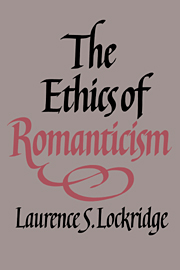1 - In pursuit of the ethical
Published online by Cambridge University Press: 16 September 2009
Summary
The best metaphysical road
Among the earlier works of Blake, Wordsworth, Hazlitt, and Shelley are explicit treatments of ethics: Blake's “Annotations to Lavater” (probably written in 1788 or early 1789), Wordsworth's “Essay on Morals” (1798–9), Hazlitt's Essay on the Principles of Human Action (1805), and Shelley's Notes to Queen Mab (1813) and his “Speculations on Morals” (1817, 1821). In Biographia Literaria (1817) Coleridge recalls that he “retired [on December 31, 1796) to a cottage in Somersetshire at the foot of Quantock, and devoted my thoughts and studies to the foundations of religion and morals” (BL I 200; cf. BL I 187). His most extensive ethical treatise is written years later as part of the still unpublished Opus Maximum, but his concern with ethics as a discipline appears in his earliest essays, letters, and notebook entries. Keats, too, plans in April, 1818, to retire from the world and take on wisdom, after finding out from Hazlitt “the best metaphysical road I can take.” He probably has in his possession a copy of Hazlitt's Essay. And one day before his twentieth birthday, Byron gives in a letter his most pointed exposition of an ethical orientation, a qualified Epicureanism.
More often than not, “philosophy” or even “metaphysics” means moral philosophy for the Romantics. Their youthful interest in the subject argues in itself its importance to them.
- Type
- Chapter
- Information
- The Ethics of Romanticism , pp. 13 - 38Publisher: Cambridge University PressPrint publication year: 1989

